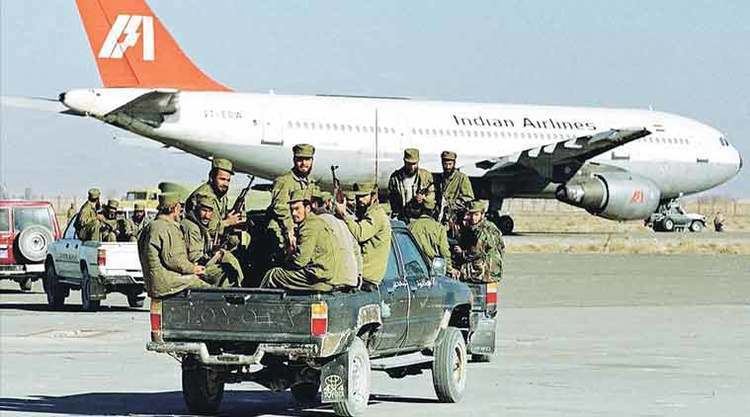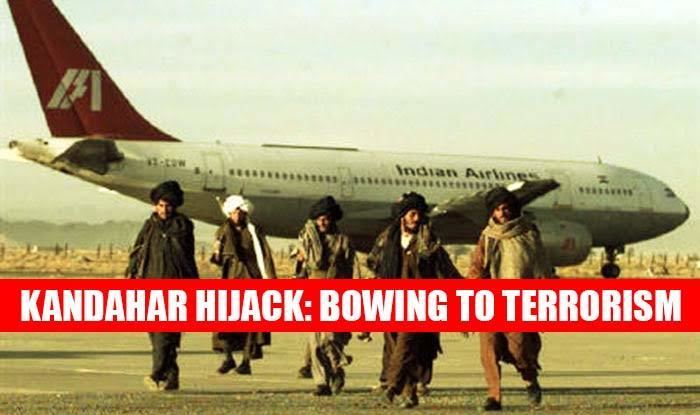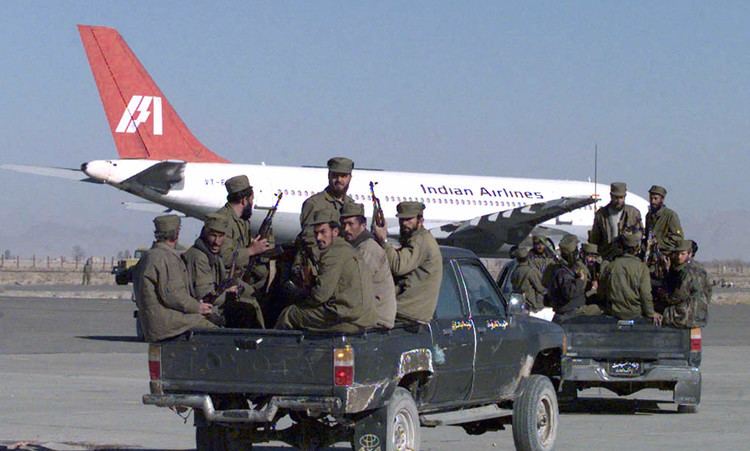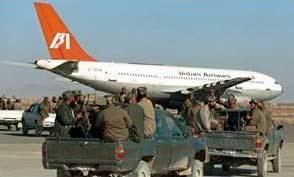Passengers 176 Survivors 190 Registration VT-EDW Summary Aircraft hijacking Operator Indian | Crew 15 Aircraft type Airbus A300B2-101 Start date December 24, 1999 Injuries (nonfatal) 17 Fatalities 1 (Rupan Katyal) | |
 | ||
Site Hijacked in Indian airspace between Kathmandu, Nepal and Delhi, India; landed at Amritsar, India; Lahore, Pakistan; Dubai. United Arab Emirates and Kandahar, Afghanistan. Similar 1971 Indian Airlines hi, 2001 Indian Parliame, Air Transat Flight 236, Atlantic Airways Flight 670, TWA Flight 847 | ||
Indian Airlines Flight 814 commonly known as IC 814 was an Indian Airlines Airbus A300 en route from Tribhuvan International Airport in Kathmandu, Nepal to Indira Gandhi International Airport in Delhi, India on Friday, 24 December 1999, when it was hijacked. Harkat-ul-Mujahideen was accused of the hijacking.
Contents
- Hijacking
- Landing in Amritsar India
- Landing in Lahore Pakistan
- Landing in Dubai UAE
- Landing in Kandahar Afghanistan
- Negotiations
- Aftermath
- References

The aircraft was hijacked by gunmen shortly after it entered Indian airspace at about 17:30 IST. Hijackers ordered the aircraft to be flown to several locations. After touching down in Amritsar, Lahore and Dubai, the hijackers finally forced the aircraft to land in Kandahar, Afghanistan, which at the time was controlled by the Taliban. The hijackers released 27 of 176 passengers in Dubai but fatally stabbed one and wounded several others.

At that time most of Afghanistan, including Kandahar where the plane landed, was under Taliban control, who resisted allowing the plane to land there. After eventually granting the plane landing rights, the Taliban still pressured the hijackers to release the hostages and give up on some of their demands. Taliban fighters surrounded the aircraft to prevent any Indian military intervention.

The motive for the hijacking appears to have been to secure the release of Islamist figures held in prison in India. The hostage crisis lasted for seven days and ended after India agreed to release three militants – Mushtaq Ahmed Zargar, Ahmed Omar Saeed Sheikh and Maulana Masood Azhar. These militants have since been implicated in other terrorist actions, such as the kidnap and murder of Daniel Pearl and Mumbai terror attacks.

Hijacking

Anil Sharma, the chief flight attendant on IC-814, later recalled that a masked, bespectacled man threatened to blow up the plane with a bomb and ordered Captain Devi Sharan to "fly west". Four other men wearing red masks then stood up and took positions throughout the aircraft. The hijackers wanted Captain Sharan to divert the aircraft over Lucknow and head towards Lahore. However, there was insufficient fuel. Captain Sharan told the hijackers that they had to land in Amritsar, India.
Landing in Amritsar, India

At Amritsar, Captain Sharan requested refuelling for the aircraft. However, the Crisis Management Group in Delhi directed Amritsar Airport authorities to ensure that the plane was immobilised. The armed personnel of the Punjab police were already in position to try and do this. They did not receive approval from New Delhi. Eventually, a fuel tanker was dispatched and instructed to block the approach of the aircraft. As the tanker sped towards the aircraft, air traffic control radioed the pilot to slow down, and the tanker immediately came to a stop. This sudden stop aroused the hijackers' suspicion and they forced the aircraft to take off immediately, without clearance from air traffic control. The aircraft missed the tanker by only a few feet.
Landing in Lahore, Pakistan

Due to extremely low fuel level, the aircraft requested an emergency landing in Lahore, Pakistan. Pakistan initially denied the request. Pakistan also shut down their air traffic services, thus effectively blackening the whole of Pakistan airspace for the Indian Airlines flight and switched off all lights at Lahore Airport. With no help from ATC, Captain Sharan banked on his visual instincts and began descending on what he thought was a runway only to find out that it was a well-lit road and aborted landing the aircraft in time. On understanding that the only other option for the aircraft was to crash land, Lahore Airport switched on its lights and allowed the aircraft to land. Lahore airport officials refuelled the aircraft and allowed it to leave Lahore at 22:32 IST. Pakistani officials rejected the pilot's request to offload some women and children passengers due to tense relations with India.
Landing in Dubai, UAE
The aircraft took off for Dubai where 27 passengers aboard the flight were released. The hijackers also released a critically injured 25-year-old male, Rupan Katyal, who was stabbed by the hijackers multiple times. Rupan had died before the aircraft landed in Al Minhad Air Base, in Dubai. Indian authorities wanted to carry out a commando hijack specialist operation in Dubai involving Indian military officials, which was rejected by the UAE government.
Landing in Kandahar, Afghanistan
After the aircraft landed in Kandahar, Taliban authorities, in an attempt to gain international recognition, agreed to co-operate with Indian authorities and took the role of mediators between the hijackers and the Indian government. Since India did not recognise the Taliban regime, it dispatched an official from its High Commission in Islamabad to Kandahar. India's lack of previous contact with the Taliban regime complicated the negotiating process.
However, the intention of the Taliban was under doubt after its armed fighters surrounded the aircraft. The Taliban maintained that the forces were deployed in an attempt to dissuade the hijackers from killing or injuring the hostages but some analysts believe it was done to prevent an Indian military operation against the hijackers.
Negotiations
Ahmed Omar Saeed Sheikh, who had been imprisoned in connection with the 1994 Kidnappings of Western tourists in India, went on to murder Daniel Pearl and also allegedly played a significant role in planning the September 11 attacks in the United States.
After the three militants landed in Kandahar, the hostages aboard the flight were freed. On 31 December 1999, the freed hostages of the Indian Airlines Flight 814 were flown back through special plane.
Meanwhile, the Taliban had given the hijackers ten hours to leave Afghanistan. The five hijackers departed with a Taliban hostage to ensure their safe passage and were reported to have left Afghanistan.
Aftermath
The case was investigated by Central Bureau of Investigation (CBI) which charged 10 people out of which seven including the five hijackers were still absconding and are in Pakistan.On 5 Feb 2008, a special anti hijacking Patiala House Court sentenced all three convicts namely Abdul Latif, Yusuf Nepali and Dilip Kumar Bhujel to life imprisonment. They were charged for helping the hijackers in procuring fake passports and to take weapons on board. However, CBI moved Punjab and Haryana High Court demanding death penalty (instead of life imprisonment) to Abdul Latif. The case is set to come up for regular hearing in high court in September 2012. On 13 September 2012,the Jammu and Kashmir Police arrested terror suspect Mehrajuddin Dand, who allegedly provided logistical support for the hijacking of IC-814 in 1999. He allegedly provided travel papers to IC-814 hijackers.
Captain Devi Sharan (Commander of IC814) recounted the events in a book titled 'Flight into Fear – A Captain's Story' (2000). The book was written in collaboration with journalist Srinjoy Chowdhury.
Flight Engineer Anil K. Jaggia also wrote a book specifically depicting the events unfolded during the hijacking ordeal. His book is titled 'IC 814 Hijacked!'. The book was written in collaboration with Saurabh Shukla.
The CBI's application to convert the life imprisonment of Abdul Latif to a death sentence has been rejected. Also, Abdul Latif's application to decrease his sentence from life imprisonment has been rejected.
